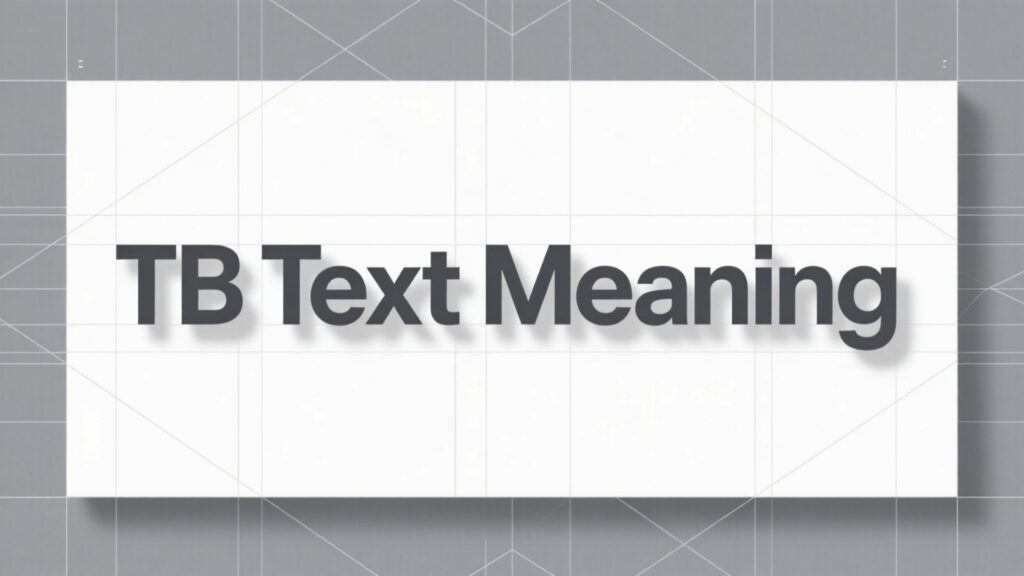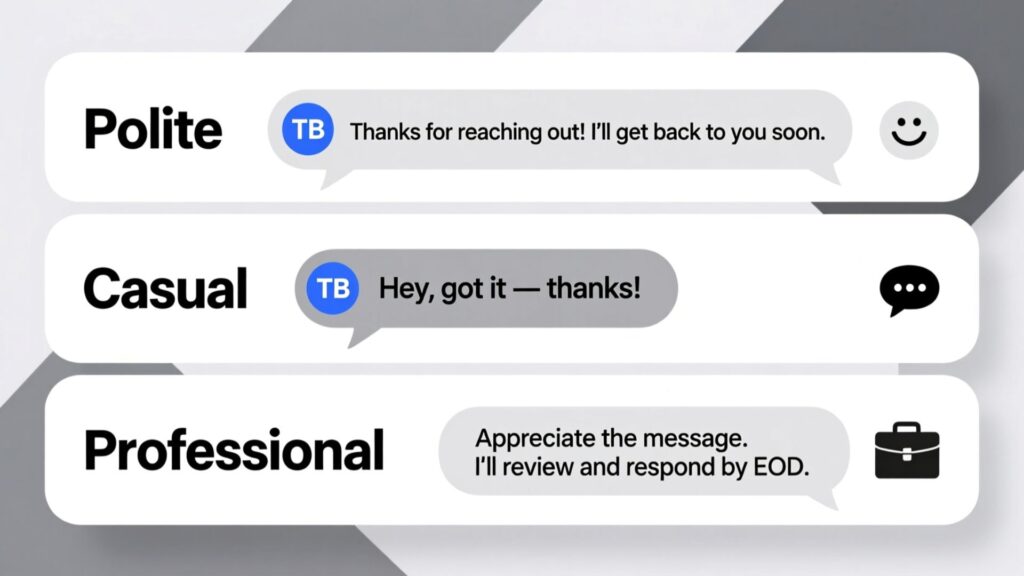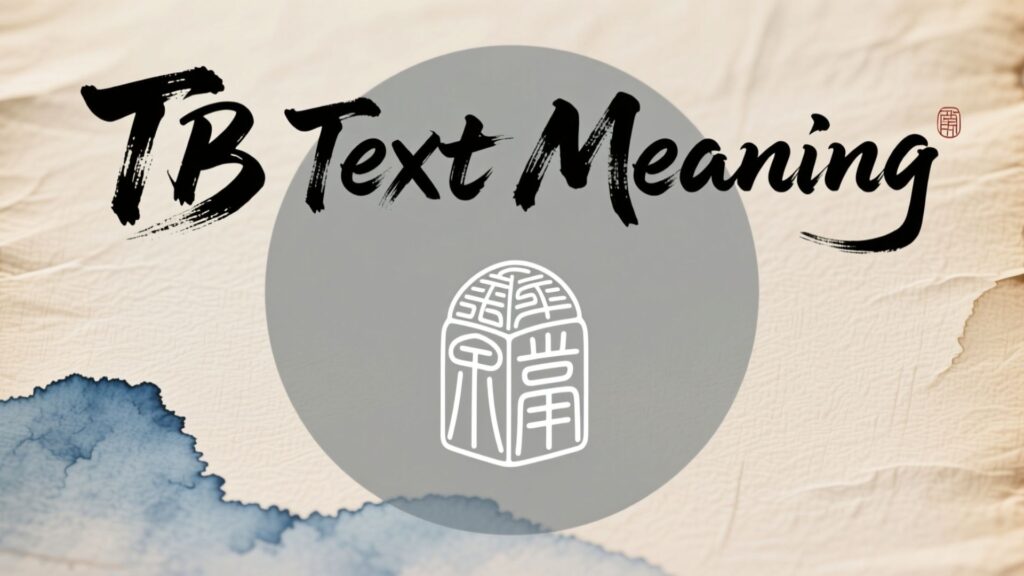Texting abbreviations aren’t just cute shortcuts they carry tone, intent, and sometimes confusion. Among them, “TB” is one you’ll see often, but might misinterpret. In this article, you’ll learn what does TB mean in text, explore tb meaning in text / tb meaning slang / tb text meaning, and get a toolbox of replies polite, casual, and professional that suit your style and audience.
Let’s dive in.
Introduction: Why “TB” Still Matters in 2025

Language evolves fast. Two decades ago, “LOL” felt futuristic. Today, people write entire paragraphs in acronyms. Amid that swirl, “TB” sticks around. But it doesn’t mean the same thing to everyone.
When you receive a message with “TB,” do you:
- Ask yourself “What does TB mean in text?”
- Wonder if it’s a slang/abbreviation or a typo?
- Panic if you’re in a formal chat should you reply or ignore?
You’re in the right place. In this post I’ll clarify tb meaning in text, show you how to reply (with tone control), and explain when not to use “TB.” By the end, you’ll feel confident decoding and responding.
What Does “TB” Mean in Text Messages?
At its core, when people ask what does TB mean in text, here are the most frequent interpretations:
- Text Back a gentle nudge to reply
- Throwback referring to something in the past, especially in social media
- (Rarely) Talking ‘Bout / Talking About in some slang contexts
Let’s break these down and give examples.
Text Back (the most common in messaging)
This usage occurs when someone sends “TB,” “TB when you can,” or “TB pls,” meaning please text back. It’s shorthand, casual, and often used in direct messages or everyday chats.
- Friend: “TB when free”
- You: “On it, texting now.”
Because it’s short, it sometimes feels abrupt. Context and relationship soften or stiffen it.
Throwback (social media / nostalgic usage)
On platforms like Instagram, Twitter, or TikTok, “TB” often signals a memory or a flashback. It’s linked to #TBT (“Throwback Thursday”) but people drop “TB” more generally now.
- Caption: “TB to summer 2015 ☀️”
- Post: “TB when we road-tripped across Europe.”
Here, tb meaning in social media leans toward nostalgia.
Talking ‘Bout / Talking About
This is less common, but some slang users shorten “talking about” to “TB.”
- “She TB the new movie was awesome.”
- “What are you TB?”
If you see something like that, you’ll know from context whether they meant “talking about” or “text back.”
Other Meanings & Non-slang Uses
Outside casual messaging, “TB” has many definitions storage (terabyte), disease (tuberculosis), elements, etc. But rarely do those arise in texting unless the topic demands it.
| Usage Context | “TB” Meaning | Typical Situation | Example |
|---|---|---|---|
| Casual texting | Text Back | Friend waiting on reply | “TB when free” |
| Social media post | Throwback | Sharing nostalgic memory | “TB to high school days” |
| Slang talk | Talking ‘Bout | Informal speech | “He TB he’s done with that job” |
| Technical / medical | terabyte / tuberculosis | Very specific conversation | “Need 2 TB storage” |
If you find “TB” in a context that doesn’t match any of these, it’s safe to ask: “Do you mean ‘text back’ or ‘throwback’?”
Tone and Context: Why They Change Everything
Two people can write the same letters “TB” but mean drastically different things. Why? Because tone, timing, punctuation, and relationship matter. Think of texting like spoken language: your voice, pauses, and inflection shift meaning.
Here’s how tone and context influence tb meaning in text:
Polite vs Impatient
- “TB when you can 🙂” is patient and respectful.
- “TB asap!” feels urgent, maybe pushy.
Formal vs Casual Settings
- In a work chat: “Please text back when available.”
- With a close friend: “TB me 😂”
If you use “TB” in a formal context, it might sound lazy. Always adjust to the setting.
Punctuation & Emojis Matter
- “TB?” soft question
- “TB!” more urgent
- “TB 😊” friendly nudge
These tiny marks change how your message lands.
Timing / Delays
If someone sends “TB” after hours, tone changes. It might feel like pressure. If you’re slow to respond, you risk confusion or irritation. Timeliness becomes part of your tone.
Relationship Factor
You’ll get more leeway with close friends. With seniors or clients, you need cleaner phrasing. A slight tweak “Could you please reply when free?” makes all the difference.
How to Reply to “TB” Texts: Polite, Casual & Professional Examples

Knowing tb text meaning is half the battle. The other half? Replying smartly. Match your response style to the sender, situation, and your relationship. Below are sets of replies you can adapt.
Polite Replies (Neutral, Respectful)
Use these when you want to stay gracious but not overly informal.
- “Thanks for your patience just replying now.”
- “I appreciate the nudge. Responding shortly.”
- “I got your message. I’ll text back after checking.”
- “Apologies I just saw your TB. On it now.”
- “I’ll get back to you in a moment.”
These keep you sounding considerate and dependable.
Casual Replies (Friends, Informal Chats)
Perfect when the sender is someone close or laid-back.
- “Oops, my bad texting back now!”
- “Haha, you caught me. Here’s my reply!”
- “Just saw your TB. What’s up?”
- “Sorry I ghosted, I’m here now 😅”
- “Chill, I was about to message you too.”
These carry warmth and personality.
Professional Replies (Work, Clients, Colleagues)
Use precision and decorum. Avoid sounding slack.
- “Thank you for following up. I’ll respond shortly.”
- “Acknowledged I’ll revert with details soon.”
- “I received your TB. Thanks. I’ll send a response by EOD.”
- “Thank you for your patience. I’ll provide an update shortly.”
- “Please allow me a moment; I’ll send everything your way soon.”
Here, clarity and courtesy rule.
Choosing the Right Reply: What to Consider
Before tapping “send,” pause and check these factors:
- Who’s texting you?
Use more formal tone with unknown or senior contacts. - How long’s the delay?
The longer you wait, the more apologetic your tone should be. - Channel / setting
Work chat vs personal DM vs group text. - Intent behind “TB”
Was it a casual check-in or urgent request? - Clarity & politeness
Always aim to reduce ambiguity and add gratitude.
| Factor | Why It Matters | Quick Tip |
|---|---|---|
| Sender | Influences tone | Boss = polished, Friend = relaxed |
| Delay length | Sets expectation | “Sorry for delay, replying now” |
| Medium | Adjust formality | Slack/teams vs WhatsApp DM |
| Context | Signals urgency | “TB asap” vs “TB when free” |
| Courtesy | Builds rapport | Always acknowledge receipt |
If in doubt: err toward a more polite version. You can never regret respect.
Why You Should Avoid Using “TB” in Formal Settings
“TB” can feel lazy, vague, or even rude when misused in serious contexts. Here’s why you should avoid it:
- Lacks professionalism It’s slang, not a business phrase.
- Ambiguous meaning The reader might misinterpret (“throwback” vs “text back”).
- Cultural or generational gap Not everyone uses or understands texting slang.
- Tone risk It may appear demanding or disrespectful.
Instead, use full expressions:
- “Please text me back when convenient.”
- “Looking forward to your reply.”
- “Kindly respond at your earliest convenience.”
- “Could you provide a response by tomorrow?”
These alternatives preserve clarity and respect.
Polite Alternatives to “TB” (When You’re the One Messaging)
If you’re the one initiating a request, better options exist besides “TB.” Choose depending on your tone and audience.
Casual Alternatives
- “Ping me back when you can.”
- “Text me when free.”
- “Hit me up later.”
Friendly Alternatives
- “Let me know when you see this.”
- “Drop me a reply when convenient.”
- “Shoot me a quick message back.”
Professional Alternatives
- “Please get back to me when convenient.”
- “I look forward to your reply.”
- “Kindly confirm once you’ve reviewed.”
- “Could you please respond by EOD?”
These speak your intention clearly without slang baggage.
Cultural & Generational Context: How “TB” Varies
Trends in language shift across generations and geographies. “TB” usage shows this clearly.
Generational Differences
- Gen Z / younger users interpret “TB” immediately as “text back.”
- Millennials may see both “text back” or “throwback” depending on context.
- Older generations might not recognize either meaning, or interpret “TB” literally (disease, measurement, etc.).
Regional / Cultural Nuances
- In some countries, texting slang isn’t widespread in formal settings.
- Digital etiquette may vary what’s fine in one culture may seem disrespectful in another.
- English as a second language users might misread or refuse slang.
Case Study: A manager in Tokyo texted a team “TB pls.” Some international employees didn’t respond they assumed “TB” meant something else. Later, the manager switched to “Please reply when you can,” and got full responses.
Cultural awareness can prevent miscommunication.
Quick Reference: Do’s and Don’ts of “TB” Use & Replies
✅ Do’s
- Match tone to your relationship.
- Reply promptly to avoid awkwardness.
- Add politeness markers like “thanks,” “sorry,” or “please.”
- Use clear phrasing if formality is expected.
❌ Don’ts
- Don’t use “TB” in emails, reports, or formal documents.
- Don’t delay too long without acknowledging.
- Don’t waste “TB” on complex or serious matters.
- Don’t assume everyone knows the meaning.
Real-World Examples & Mini Case Studies
Case Study 1: Friend Check-In
- Friend: “TB when you can 😊”
- You (casual): “Hey! Just saw this, texting now 😄”
Case Study 2: Client in Slack
- Client: “TB on the contract revisions”
- You (professional): “Thank you for following up. I’ll review now and revert with changes by EOD.”
Case Study 3: Group Chat of Mixed Age
- Younger member: “TB whenever”
- Older member: “Please respond to this message when you have time.”
- Outcome: Younger uses “TB,” older uses full version. Mixed usage, but meaning stays clear.
Quote from a Social Media Expert:
“Abbreviations like ‘TB’ reflect how brevity and tone now play lead roles in digital speech. But clarity must never take a backseat.”
Wrap-Up: Master TB Meaning & Replying Wisely
Congratulations you now know:
- What does TB mean in text? It usually means text back in messaging contexts.
- TB meaning slang / tb meaning in text / tb text meaning vary by platform and tone.
- tb meaning in social media often leans toward throwback.
- How to reply with polite, casual, or professional tone.
- When to avoid using “TB” altogether.
- Cultural, generational, and situational shifts in interpretation.
Next time someone sends “TB,” you won’t hesitate. You’ll decode tone, choose a fitting reply, and stay respectful across settings.
Final Tip: Good communication isn’t about speed it’s about clarity. Whether you say “TB” or spell it out, aim to be clear, courteous, and human.
Bugti is the founder of Quoethint.com, a hub for English language tips, writing advice, and grammar guidance. With years of experience in English studies and a passion for clear communication, Bugti created this platform to make grammar and writing easy to understand for everyone.
